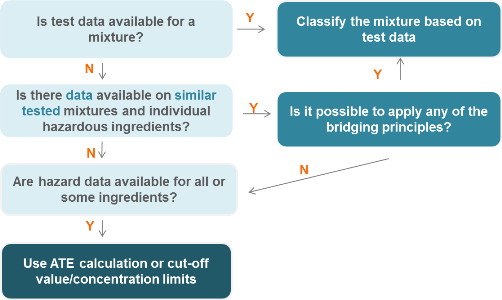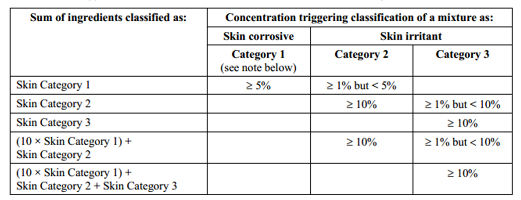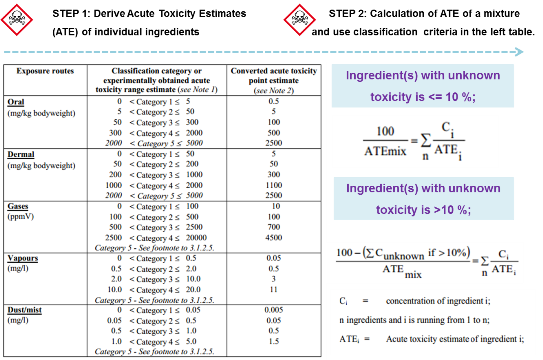GHS Classification of Mixture
Little Pro on 2016-01-06
GHS classification of mixture is complex mainly because it is impossible to test every mixture to obtain the data needed for classification. Most of the mixtures on market are classified based on the available data of ingredients in them. In this article, we will take a close look at how to classify mixtures under GHS with a focus on bridging principles and cut-off value/concentration limit.
For detailed information and guidance on classification, refer to the UN GHS Purple Book or country-specific GHS regulation.
How to Classify Mixtures under GHS - General Principles
- If data is available for a mixture itself, classification will be based on that data;
- For physical hazards, classification of a mixture mainly relies on testing;
- If health hazard or environmental hazard data is not available for a mixture, try using Bridging Principle first;
- If Bridging Principles do not work, mixtures will be classified based on available data on the individual ingredients using cut-off values/concentration limits;
The picture below is a decision-tree showing you how to decide which approach is used when classifying a mixture under GHS.

Bridging Principles
Bridging principles are mainly used to classify un-tested mixtures under GHS. There are 6 bridging principles in GHS and they are listed as follows:
- Dilution: Tested mixture A is diluted with less or equally hazardous ingredient B. A+B=A;
- Batching: Mixture A & B are two batches produced under same conditions. A=B;
- Concentration of highly hazardous mixtures: Mixture A is classified at its highest hazard category, for example, acute toxicity category 1. B is more concentrated than A. B=A;
- Interpolation:Mixture A and B share the same hazardous ingredient and classification. If the concentration of the hazardous ingredient in mixture C is in-between, C=A=B;
- Substantially similar mixtures:For two mixtures A+B and C+B, if A is similar to C in concentration & hazard data and B's concentration is similar in two mixtures, A+B=C+B;
- Aerosol:A mixture in aerosol form is considered to have the same classification as the non-aerosolised form of a mixture provided that the propellant does not affect the hazards of the mixture.
It shall be noted that not all bridging principles above apply to every mixture. For more info about the applicability of bridging principles, please click here.
GHS Cut-off Value and Concentration Limits
GHS cut-off value or concentration limit is the minimum concentration of a hazardous substance to trigger the classification of a mixture. The table below shows the cut-off value/concentration limit for skin corrosion/irritation. If a mixture contains a hazardous ingredient that has been classified as skin corrosive category 1, the mixture itself will also be classified as skin corrosive category if the concentration of ingredient exceeds 5%.

In GHS, the cut-off value and concentration limit are equivalent and meant to be used interchangeably. It shall be noted that the EU CLP regulation has given different definitions to cut-off value and concentration limit. In addition to that, Europe has set specific concentration limits for specific substances.
- Cut-off value: minimum concentration for a substance to be taken into account for GHS classification purposes(do not necessarily trigger classification);
- Concentration limit: minimum concentration for a substance to trigger the classification of a mixture for a specific hazard class;
- Specific concentration limit: a concentration limit that is specific to a substance and takes precedence over generic concentration limit or cut-off value.
Special Considerations When Using GHS Cut-off Value and Concentration Limit
There are some special considerations when using cut-off value and concentration limit to classify a mixture:
- Reliability: Test data always takes precedence over cut-off value/concentration limit and is more reliable;
- Additivity Principle: If a mixture contains two or more ingredients with the same or similar hazards, the concentration of the hazardous ingredients shall be added first. This is based on the assumption that each ingredient contributes to the overall toxicity of the mixture in proportion to its potency and concentration. However, this additivity principle does not apply to non-additive hazard classes.
| Additive hazards |
|
| Non-additive hazards |
|
Acute Toxicity Classification of a Mixture
For acute toxicity, the GHS cut-off value is expressed as Acute Toxicity Estimates (ATEs) instread of % concentration. For a mixture containing a substance that has been classified as acutely toxic, you need to calculate the ATEs of the mixture first and then compare it against the classification criteria below to determine the acute toxicity category of a mixture.
Read more: Examples of acute toxicity classification for mixture
Reference & Resources
- Introduction to GHS Classification by the United Nations
- Example of Mixture Classification - ECHA
- A Summary of GHS Classification Criteria for Substance and Mixtures
- Download Cut-off Value for Health Hazards;
- Download Cut-off Value for Environmental Hazards.
Having Questions?
We do not provide consultancy services. If you have questions or need any help, please contact our sponsor. You may also find an expert in CSP business directory below. If you are a consultant, you may get yourself listed in CSP business directory (free) or sponsor this page to leave your contact info on this page..

Tags: Topics - GHS, GHS Basics and Tutorials
